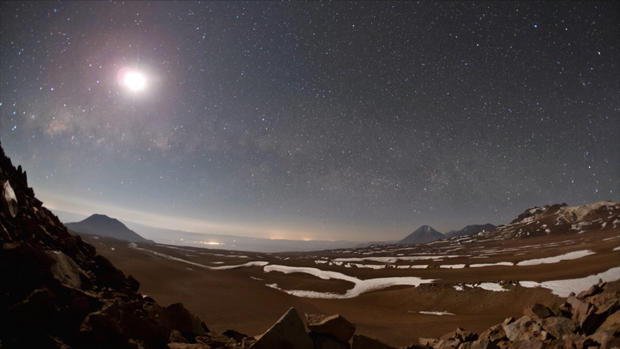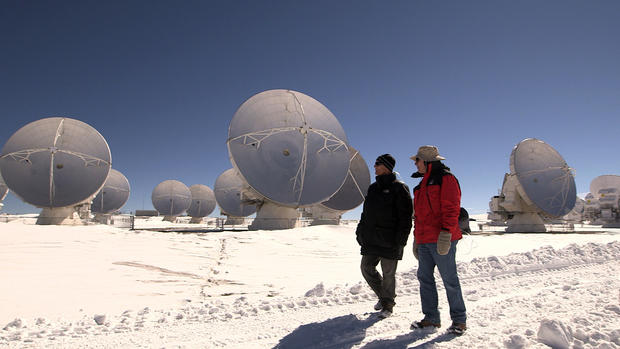ALMA: Peering into the universe's past
The following script is from "ALMA" which aired on March 9, 2014, and was rebroadcast on July 27, 2014. Bob Simon is the correspondent. Michael Gavshon and David Levine, producers.
At this very moment, astronomers are exploring parts of space that have never been seen before. They are seeing the actual birth of planets and stars, countless millions of them, from the top of a remote plateau in Northern Chile. Deep in the Atacama Desert, they've built a revolutionary new observatory, known as the Atacama Large Millimeter/submillimeter Array, ALMA for short. It's a different kind of telescope, not the kind you look through.
ALMA is the world's most powerful radio telescope, which means it deciphers wave lengths of light -- colors really -- that the human eye cannot see, giving scientists a window on parts of the universe that are otherwise invisible. It's a project that's been 30 years in the making and cost $1.3 billion. ALMA is just getting started, and as we reported last March, has already made some astonishing discoveries.
For centuries, people have come to this high plateau in Northern Chile to look far into the heart of space. It's called Chajnantor, which means "place of departure." As these time lapse pictures show, it is the Earth's window to the stars. At 16,500 feet, it's above most of the Earth's atmosphere, there's very little here separating man from the heavens. The result is a night's sky that's more brilliant than anything you can see without actually being in orbit.
The landscape is otherworldly, and the harsh terrain stretches hundreds of miles. But the same features that make the desert so inhospitable also make it an ideal place to gaze at the galaxies. It's high and it's dry. ALMA is comprised of 66 radio antennas. The expertise and technology assembled here make it the most ambitious astronomical project on Earth.
Bob Simon: Has there ever been an enterprise on this scale before?
Pierre Cox: On this scale, no. It's the biggest one.
Pierre Cox is ALMA's Director. His job is to coordinate the 19 different countries involved in the project.
Pierre Cox: When I took my job, people said, "Oh my goodness. That would be like being the Secretary General of United Nations."
Bob Simon: That's what I would have thought.
Pierre Cox: I thought it also. But then I thought a little bit about it. And I think no. It's much easier, because all the members have the same goal, which is not true for the United Nations.
But it is a herculean task. Everything you see here had to be manufactured in Europe, Asia and North America, and shipped to the Atacama. It was assembled and tested here at ALMA's base camp at the foot of the mountain, an altitude of 10,000 feet.
Then the trip to the top at eight miles-an-hour. Each one of these $7 million instruments has to make the 17-mile journey on a specially built transporter: more crab than carrier, designed to protect this ultrasensitive cargo from even the slightest bump in the road.
Bob Simon: You put one of these on a truck?
Pierre Cox: Yes.
Bob Simon: Haul it up to 5,000 meters, more than 16,000 feet, and you still expect the kind of accuracy--
Pierre Cox: Yes.
Bob Simon: --that is a tiny fraction of a human hair?
Pierre Cox: Yes, that gives you an idea about how complex this whole endeavour is.
It's a journey into thin air. The altitude is such a strain on the body that you have to pass a medical exam to go there.
Bob Simon: Do you find that when you're on top your thinking gets a little bit hazy?
Pierre Cox: Yes, sometimes it does. I mean, people react very differently. There are people who are starting to babble all the time. Other ones who don't say a word.
Very little can survive at these heights. There's a point at which even the llamas stop climbing. We came here in May - the middle of fall in the Southern Hemisphere. It's supposed to be the driest place on Earth. We found snow.
Bob Simon: You know what's going on at a trillion miles from here. But you couldn't forecast the weather.
Pierre Cox: Yeah, that's right. So we have to live with it. There you see the antennas.
Bob Simon: My God, what a sight. That looks extraterrestrial.
Pierre Cox: It is. It's absolutely mind-boggling.
We were fitted with oxygen tanks. Still, we found it difficult to think or breathe or walk.
Right now the antennas are spread out on the plateau over a distance of a mile. But they're moveable, and eventually, they could spread out over 10 miles. That will mimic a single telescope dish 10 miles wide.
Then, ALMA will be able to see far off objects with greater detail than ever before. And because light takes so long to get to us from distant objects, the farther away ALMA sees the farther back in time it looks. Soon, they will be able to get close to the start of it all, to the Big Bang. ALMA will offer us a glimpse at the formation of the very first galaxies 13 billion years ago.
Bob Simon: The very first galaxies?
Pierre Cox: Yes. The ones which were born just after the Big Bang, about a billion years after the Big Bang.
Bob Simon: Just after the Big Bang is a billion years
Bob Simon: --after the Big Bang--
Pierre Cox: In terms of astronomy we have those terms.
Bob Simon: And that's never been before?
Pierre Cox: No, or very few.
ALMA's brain is a supercomputer housed in one of the highest buildings in the world, second only to a tiny train station in the Tibetan Himalayas. Physicist Alison Peck helped oversee ALMA's construction.
Alison Peck: We had to oxygenate the entire room. That means we need to-- needed to pump additional oxygen into the room in order for the guys to be able to make decisions correctly, to focus correctly, to compensate for the altitude.
Bob Simon: So they wouldn't have been able to do this without oxygen?
Alison Peck: There's absolutely no way they would have been able to assemble this without additional oxygen.
Bob Simon: Has anything like this ever been done before?
Alison Peck: Not at this altitude, no. This is definitely the highest altitude supercomputer in the entire world.
It's as powerful as three million laptops and it synchronizes all the data coming in from those antennas.
Bob Simon: How precise does the computer have to be?
Alison Peck: This computer has to be able to synchronize the data to within just a few femtoseconds.
Bob Simon: What's that?
Alison Peck: That is a millionth of a billionth of a second.
ALMA isn't actually the world's highest telescope. Hubble, for example, has been orbiting hundreds of miles above the Earth for more than two decades. But Hubble is an optical telescope, a very different creature from ALMA.
Alison Peck: ALMA is a radio telescope which means that we are observing things that are radiating at wavelengths longer than what the eye can see. Optical telescopes observe the visible light. They observe things that light up that we can see with our eyes.
Bob Simon: So, ALMA can see colors that we cannot see?
Alison Peck: Effectively, yes. ALMA can see wavelengths of light that we cannot see with our eyes.
Take a look. What you're seeing is an image from an optical telescope. It looks like little more than a dark cloud in space. But THIS is how ALMA sees it. Suddenly that cloud is lifted.
Bob Simon: What's there?
Alison Peck: Gas, generally, and dust. And that doesn't sound so exciting when you say that. I mean, dust-- we just vacuum it up, normally. But in the context of the evolution of galaxies and solar systems, dust is extremely important.
It's in these dense patches of gas and dust where stars, new solar systems, are born. And that's exactly what we're seeing in this picture: a new star.
Alison Peck: Hubble can see stars immediately after they're born. But it can't detect the regions before the stars are born. It can't see the cradles, if you will, where the stars will appear.
Bob Simon: Hubble sees the baby, you're seeing the birth?
Alison Peck: Exactly. That's exactly right.
Not just the birth of stars, ALMA can also see planets as they form. Stuart Corder is ALMA's deputy director. Inside the control room, he showed us some of the remarkable things they're already observing.
Bob Simon: So essentially, in language I can understand, we are looking at a young star.
Stuart Corder: Young star, yes.
Bob Simon: And we're looking at the birth of planets around it.
Stuart Corder: Right. Yeah, I mean, the-- the emit-- the-- the colors that we're seeing in the image are the gas around the star. And that gas, and the dust that's also surrounding the star, eventually comes together into small pebbles, and then large rocks, and then bigger rocks, and eventually forms planets. So I mean, this is really the-- you're seeing the natal environment of planets.
This ALMA graphic illustrates just how new planets are formed.
But will there be life on them? We all know that's the ultimate question. And even at this early stage in its journey, ALMA has seen evidence that there might be. It has identified chemicals close to newborn stars that are similar to what we find here on Earth, which form the building blocks of life.
Alison Peck: We found a simple sugar called glycolaldehyde. Now this is a molecule that we consider pre-biotic. That means that it could lead to conditions where life could form
Bob Simon: Excuse me. I can't resist. There's sugar out there?
Alison Peck: Yes. There's sugar out there, there's alcohol.
Bob Simon: This is very good news.
Alison Peck: Yes, indeed. Indeed.
The scientists at ALMA aren't the first people to gaze at the skies from this desert. For generations, the indigenous people of the Atacama were fascinated, not by the brilliance of the stars, but by the very same dark corners of space. Chilean physicist Eduardo Hardy, ALMA's director of North American Operations showed us how they saw the universe.
Eduardo Hardy: They saw the equivalent of constellations. But instead of looking at stars to draw the shapes of the constellations, they used the dark patches to do that.
Bob Simon: The Greeks used the stars.
Eduardo Hardy: The Greek used the stars. The local populations used the dark patches, which is precisely what ALMA is looking at.
And in these dark patches, they saw reflections of their daily lives...llamas, for example. They spun a whole mythology around them.
Bob Simon: The Milky Way.
Eduardo Hardy: Here, the Milky Way is a river. And it actually does look like a river. But it's a river that will take the souls of the dead people and take them to heaven.
It's fitting, then, that scientists at ALMA are scanning the skies on Chajnantor, this "place of departure." And even though they've already taken us far into darkness, they're just getting started.
Eduardo Hardy: We don't even know what has been discovered. People who have made observation with ALMA are working hard to get the data out and publish it. In the next few years, we will be very surprised. The only thing I can predict is that we will be very surprised.
Surprised, yes. But ALMA is destined to take science further back in space and time than had ever been imagined -- closer than ever to an understanding of what it means to say: "in the beginning."

